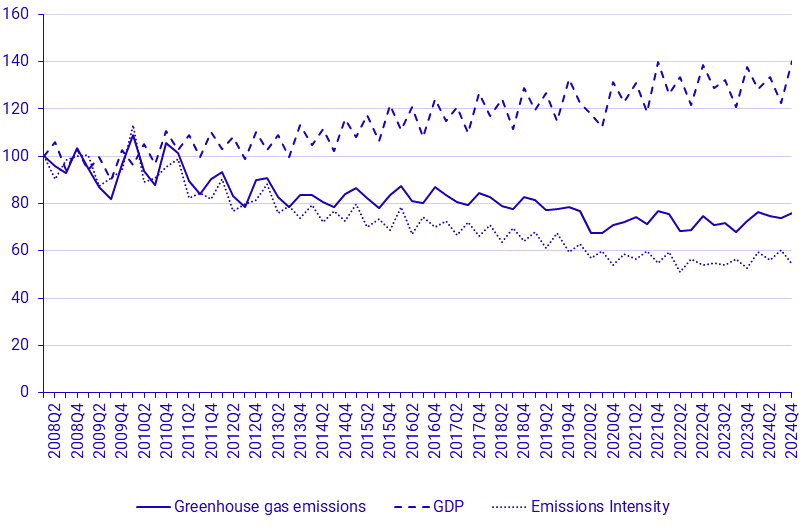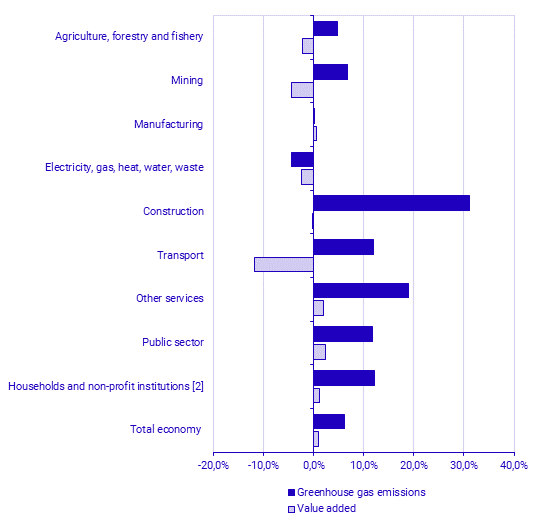Environmental Accounts – Emissions to air fourth quarter 2024 - Corrected version 2025-06-27
Greenhouse gas emissions from the Swedish economy increased in 2024
Statistical news from Statistics Sweden 2025-05-27 8.00
Greenhouse gas emissions from the Swedish economy increased in 2024 by 6.3 percent compared to the previous year. The largest increases were seen in the transport sector and from household consumption. The rise in emissions follows the same trend as previously published quarterly statistics for 2024.
Corrected version 2025-06-27
Greenhouse gas emissions from the Swedish economy increased in 2024 by 3.0 million tons compared to the previous year, totalling 51.8 million tons. This is according to preliminary emissions statistics for the full year 2024 (summed quarterly data). In addition to the increases in the transport sector and household consumption, there was also a significant increase in the construction sector.
The quarterly statistics from Statistics Sweden’s environmental accounts report preliminary production-related air emissions from Sweden’s economy, including households.
During the same period that greenhouse gas emissions increased by 6.3 percent, GDP grew by 1.0 percent. This means that greenhouse gas intensity - i.e., the greenhouse gas emissions per Swedish krona (SEK) produced in the economy - increased by 5.2 percent between 2023 and 2024.
The increase in greenhouse gas emissions can largely be attributed to increased deliveries of fossil diesel relative to total diesel usage, as shown by monthly fuel, gas and stocks statistics. The Swedish carbon reduction policy (for the share of biofuel in transport fuels) was revised in January 2024 where the share for diesel was reduced from 30.5 percent to 6 percent, and for petrol was reduced from 7.8 percent to 6 percent.
Developments for 2024 in brief
In eight out of nine aggregated sectors, the emissions increased (see table). The largest increases were found in the transport sector, construction sector, the "other services" sector, and from household consumption. The only sector where emissions decreased was electricity, gas and heating production as well as water, sewage and waste treatment and management. In the manufacturing industry, the increase was marginal, and emissions remained at the same level as the previous year. The percentages below are compared to the previous year, and greenhouse gas emissions are expressed in carbon dioxide equivalents.
- Greenhouse gas emissions from the Swedish economy increased by 6.3 percent between 2023 and 2024. This corresponds to an increase of 3.0 million tons, totalling 51.8 million tons of carbon dioxide equivalents.
- The largest increase measured in tonnes came from the transport sector, where emissions rose by 934 kilotons, or 12 percent.
- The second-largest increase came from household consumption, which rose by 934 kilotons (12 percent).
- Significant increases were also seen in the "other services" sector (521 kilotons, 19 percent) and the construction sector (501 kilotons, 31 percent).
- Within the "other services" sector, the increase was mainly in the sub-sectors Trade (SNI G45-G47), which rose by 241 kilotons (18 percent), and Rental services, travel services, and other support services (N77-N82), which rose by 107 kilotons (24 percent).
- In electricity, gas and heating production as well as water, sewage and waste treatment and management sector (SNI D35-E39), emissions decreased by 293 kilotons, or 4 percent.
- In the manufacturing industry, emissions were nearly unchanged, with an increase of 29 kilotons, or 0.2 percent.
| NACE 2007 industry | Greenhouse gas emissions | Preliminära förädlingsvärden | |||||
|---|---|---|---|---|---|---|---|
| 2024[1] | Change compared to 2023 | 2024[1] | Change compared to 2023 | ||||
| Agriculture, forestry and fishery | 8 236 | 373 | 4.75% | 60 117 | ‑1 376 | ‑2.24% | |
| Mining | 856 | 54 | 6.79% | 34 569 | ‑1 612 | ‑4.46% | |
| Manufacturing | 13 679 | 29 | 0.21% | 883 494 | 5 657 | 0.64% | |
| Electricity, gas, heat, water, waste | 6 324 | ‑293 | ‑4.42% | 152 239 | ‑3 698 | ‑2.37% | |
| Construction | 2 117 | 501 | 31.0% | 371 382 | ‑496 | ‑0.13% | |
| Transport | 8 755 | 934 | 11.9% | 167 831 | ‑22 228 | ‑11.7% | |
| Other services | 3 279 | 521 | 18.9% | 2 722 344 | 52 849 | 1.98% | |
| Public sector | 362 | 38 | 11.7% | 1 150 603 | 27 269 | 2.43% | |
| Households and non-profit institutions [2] | 8 193 | 889 | 12.2% | 67 632 | 784 | 1.17% | |
| Total economy [3] | 51 801 | 3 047 | 6.25% | 6 272 639 | 60 496 | 0.97% | |
[1] Greenhouse gas emissions and value added are preliminary and calculated based on aggregated quarterly data. [2] Only non-profit institutions provide value added. [3] The total refers to GDP at market prices, including product taxes and subsidies. The subtotals do not sum up to the total. Source: Statistics Sweden


[1] Only non-profit institutions provide value added.
Developments for the fourth quarter of 2024 in brief
In the fourth quarter of 2024, greenhouse gas emissions from the Swedish economy amounted to 13.1 million tons of carbon dioxide equivalents. This represents an increase of 5.0 percent compared to the same quarter the previous year. During the same period, GDP increased by 1.9 percent.
The emission trends for the fourth quarter largely follow the same patterns as the annual statistics. That is, the increases are primarily found in the transport sector, construction sector, "other services" sector, and private consumption.
However, one difference from the annual statistics is that, compared to Q4 2023, the manufacturing industry increased its emissions by 193 kilotons, which corresponds to a 6 percent rise.
Definitions and explanations
What do the quarterly statistics show?
The quarterly statistics from Statistics Sweden's environmental accounts report production-based emissions to air per industry from the Swedish economy, which also includes households. Production-based emissions are emissions of greenhouse gases by Swedish economic actors and differ from the territorial emissions, which instead include emissions within the national borders. The territorial emissions are used in the UN, EU and nationally to follow up climate targets. The production-based emission statistics include the emissions from Swedish companies and individuals that occur both outside and inside Sweden's borders. Production-based emissions use the same system boundary as the national economic statistics, i.e., the national accounts.
For the transport industry, emissions arising from transport companies with economic residence in Sweden are included, regardless of where in the world these emissions occur. Emissions from, e.g., foreign airlines flying to, from or within Sweden are not included.
When comparing quarters, the reader should be attentive to seasonal variation. For example, emissions from electricity, gas, heat, water, waste are higher during the winter whereas households’ consumption of diesel and petrol are higher during the summer.
Greenhouse gas emissions – carbon dioxide equivalents are calculated as an aggregate of CO2 (fossil), CH4, N2O, HFC, PFC, SF6. The conversion factors (Greenhouse Warming Potential, GWP) used to calculate carbon dioxide equivalents are the same as those used for reporting to UNFCCC [1].
[1] IPCC, 2014: Climate Change 2014: Synthesis Report. Contribution of Working Groups I, II and III to the Fifth Assessment Report of the Intergovernmental Panel on Climate Change [Core Writing Team, R.K. Pachauri and L.A. Meyer (eds.)]. IPCC, Geneva, Switzerland, 151 pp, AR5 Synthesis Report - Climate Change 2014 (ipcc.ch)
More information about emission accounts is available on the Statistics Sweden’s website Miljöräkenskaper (scb.se) under the heading (in Swedish): Dokumentation
Revisions
In the fourth quarter of 2024, a number of revisions were made to the time series, primarily due to new data from the 2023 annual calculations. This has led to revisions across the entire time series. Some of the most important updates include:
- Changes to emission factors and the biomass content in waste. A new method for calculating greenhouse gases has been applied.
- Data from the OECD is once again being used for aviation, instead of models based on aviation fuel deliveries.
Next publishing will be
The next publication regarding quarterly air emissions will be released on August 28, 2025, and will cover the first quarter of 2025.
Statistical Database
More information is available in the Statistical Database
Feel free to use the facts from this statistical news but remember to state Source: Statistics Sweden.
